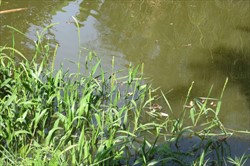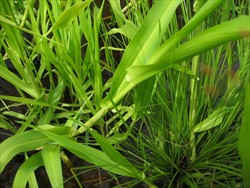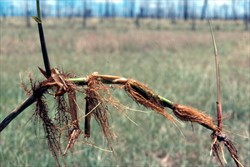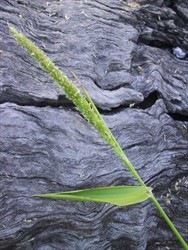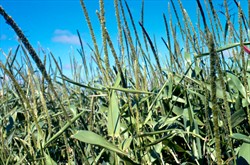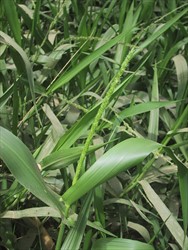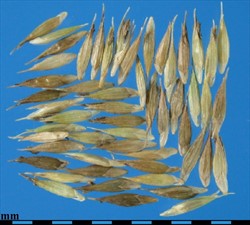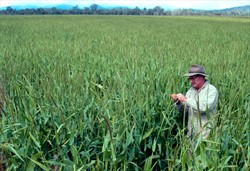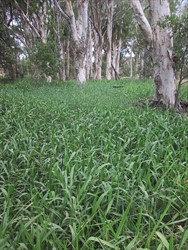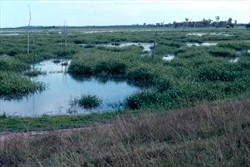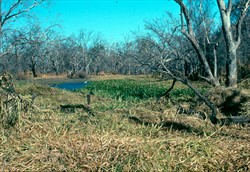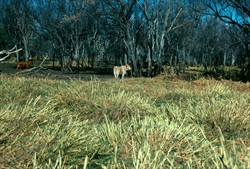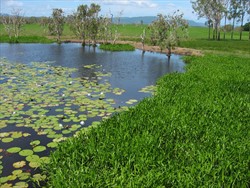Hymenachne amplexicaulis
Tropical Forages
Hymenachne amplexicaulis (Rudge) Nees
Basionym: Panicum amplexicaule Rudge
Family: Poaceae (alt. Gramineae) subfamily: Panicoideae tribe: Paspaleae subtribe: Otachyriinae.
A perennial, stoloniferous/rhizomatous grass, with robust, erect or ascending culms 1–2.5 m high and to >12 mm thick, and prostrate stems that run on wet ground, or float on water, developing adventitious roots. Stems glabrous, pithy. Leaves glossy green in colour, largely glabrous; sheaths often spongy; blades mostly linear-lanceolate, 10–45 cm long and to >3 cm wide, cordate, auriculate and clasping at base; ligule an eciliate membrane, 1–2.5 mm long. Panicle narrow, spikelike, cylindrical, 20–50 cm long, 1–2 cm across, sometimes with 2 to a few long, upright branches. Spikelets lanceolate, dorsi-ventrally compressed, upright, 3–4 (–5) mm long and 1 mm diameter; c. 2.3 million seeds/kg. Caryopsis ellipsoid, easily detached, 1–2 mm long and 0.6 mm diameter.
Note: Morphologically similar to, but distinct from Hymenachne acutigluma (Steud.) Gilliland, which is native to Continental Asia, Malesia and Australasia.
Similar species
H. amplexicaulis: leaf base cordate-auriculate, stem-clasping (amplexicaul).
H. acutigluma (Steud.) Gilliland (syn. Hymenachne pseudointerrupta Müll. Hal.): leaf base rounded to sub-cordate. Native to S and SE Asia, and northern Australia.
Asia: ចាផ្លង, ស្មៅចាផ្លង (Cambodia); 灯心草, 膜稃草 mo fu cao (China); rumput kumpai (Indonesia); lagtom (Philippines); หญ้าไส้ตะเกียง, หญ้าปล้อง ya plong, yaa plong (Thailand); bấc gián đoạn (Vietnam)
English: hymenachne, west indian marsh grass, water straw grass, trumpet grass, wick grass; dal (dhal) grass, bamboo grass (India)
Indian subcontinent: bhat dal, dhamsiria, dhop dal, karanga dal, pokalia, taboo, tattu (India)
Latin America: canarana de folha, capim-capivara (Brazil); camalote, canutillo, capií, capií camalote, carrizo, carrizo chico (Argentina); carrizo chico, cañuela blanca (Bolivia); canutillo, trompetilla (Colombia); azuche, corcho, corcho bänälaj, zacate manatí (Mexico); gamalote, gramalote (Nicaragua); chingolo (Paraguay); canela blanca, cañuela morada, canutillo, carrizo chico, hierba lancha, lengua de vaca, miuda, paja de agua, pasto paja de agua, rabo de zorro, trompetillo, yerbelancha (Spanish)
Suriname: bamboegras
Note: Asian common names probably more likely refer to Hymenachne acutigluma (Steud.) Gilliland.
Native :
Northern America: Mexico (Campeche, Chiapas, Colima, Guerrero, Jalisco, Michoacán, Nayarit, Oaxaca, Sinaloa, Tabasco, Tamaulipas, Veracruz)
Caribbean: Barbados; Cuba; Dominica; Dominican Republic; Guadeloupe; Haiti; Jamaica; Martinique; Puerto Rico; St. Lucia
Central America: Belize; Costa Rica; El Salvador; Guatemala; Honduras; Nicaragua; Panama
South America: Bolivia; Brazil; Colombia; Ecuador; French Guiana; Guyana; Paraguay; Peru; Suriname; Uruguay; Venezuela
Naturalized:
Australasia: Australia (New South Wales, Northern Territory, Queensland, Western Australia)
Northern America: USA (Florida, Louisiana)
Cultivated:
Australasia: Australia (no longer recommended due to "Declared weed" status
Forage
H. amplexicaulis has value as a cool or dry season forage in seasonally inundated land, and can also be cut for silage. Stems are too thick for effective hay-making, although it can be used in cut-and-carry systems as green feed.
Environment
It has been proposed as a nutrient sink and sediment trap in ponded/floodplain environments which have become polluted by high nutrient and/or sediment loads. It has also been proposed as a suppressant for the serious weed of tropical wetlands, Mimosa pigra L. However, both species are now on the list of Weeds of National Significance in Australia because of their invasiveness in environmentally important wetlands and any proposal towards similar usage in other parts of the world should be carefully and cautiously considered.
Other
The plant is sometimes harvested from the wild for local use as a wick.
Soil requirements
Grows well on fertile, seasonally inundated clays, although distribution is determined more by availability of water than by soil texture.
Moisture
H. amplexicaulis is a wetland species, inhabiting margins of swamps, river floodplains, and drainage canals, mostly in water to about 2 m deep, occasionally extending into water 3‒4 m deep. It can be grown for pasture in natural or artificially inundated pondage areas. On seasonally flooded floodplains, it needs over 1 m of water during the wet season to persist. It has low drought tolerance, not spreading beyond the wet zone, and low salt tolerance, not surviving even occasional tidal impact.
Temperature
Occurs from about 29º N in Florida and 19º N in Mexico to about 28º S in Argentina, mostly at low altitudes (<850 m asl, but reportedly to 1,500 m asl). This is equivalent to a range in average annual temperatures of 21‒26 ºC, with some frost incidence at the extremes. H. amplexicaulis appears better adapted to slightly lower temperatures than is H. acutigluma.
Light
Tolerant of only light shade.
Reproductive development
Appears to be primarily a short day plant with a critical daylength of about 12 hours. Flowering also appears to be stimulated in response to an extended, more intense wet season. Although plants can largely flower throughout the growing season, there is a peak flowering from March/April to late June in the southern hemisphere or September/October to late December in the northern hemisphere.
Defoliation
H. amplexicaulis is a valuable fodder resource for the dry season. It is normally not grazed at other times of the year due to the harmful effects of trampling and uprooting of plants from wet soil. However, once the soil has dried out sufficiently to carry stock, H. amplexicaulis can tolerate heavy grazing. Stands are normally stocked at one beast per 1.5‒2 ha.
Fire
By virtue of its habitat, fire is uncommon. However, fire following herbicide application can stimulate seedling growth if mature seed has fallen before herbicide treatment.
Guidelines for establishment and management of sown forages.
Establishment
H. amplexicaulis can be established vegetatively or from seed. Stem cuttings (2‒3 nodes) can be dropped into water over 10 cm deep, or runners planted in rows 5 m apart. Seed can be broadcast onto wet soil, or onto shallow water, with seedlings emerging as the pond dries out. Sowing rates of 1‒2 kg seed/ha are usually adequate. Seed viability declines fairly quickly under ambient storage conditions in the tropics (20‒30 ºC), from an initial 98% to 10% over a period of 16 months.
Fertilizer
25‒50 kg/ha N can be applied to sparse or newly established stands to promote tiller development. Plants appear to obtain nitrogen from a non-symbiotic association with nitrogen-fixing bacteria or cyanobacteria around the roots and submerged stems, reducing the reliance on fertilizers. Nitrogen fixation rates are believed to be higher in newly established stands compared with mature stands, which draw nutrient from litter decomposition and mineralisation, and eutrophication. N and P fertilizers applied at the beginning of the wet season have little effect on dry matter yield, or CP or P levels in the plant in the long term.
Compatibility (with other species)
Tends to suppress companion species.
Companion species
Grasses: Echinochloa polystachya, Urochloa arrecta (syn. Urochloa radicans), U. mutica.
Legumes: Not usually planted with legumes.
Pests and diseases
H. amplexicaulis is susceptible to fungal diseases, a leaf spot caused by Curvularia lunata and a tar spot caused by Phyllachora sp. Neither fungus is sufficiently aggressive to be a useful biocontrol agent. In Australia, rice leaffolder (Marasmia sp.) larvae attack H. amplexicaulis and H. acutigluma, causing leaf tip necrosis, much more severe in the former. Larvae of the Ocola skipper (Panoquina ocola) also feed on hymenachne. A lygaeid bug (Ischnodemus variegatus) can kill stands in localised areas, but infestations do not spread sufficiently to kill whole stands. The paddy bug (Oebalus poecilus and O. ypsilongriseus), also known as "ghundi" or "bush bug", a serious pest of rice in the Caribbean, feeds on H. amplexicaulis ), migrating to rice crops during early flowering.
Ability to spread
Seed is dispersed by floodwater and by water birds. Pieces of plants can be carried to new locations on hooves of grazing animals, or in moving water. Rafts of plant material are moved by water flow, until lodging against a bank and taking root. It has also been moved by man for use in pasture development. Surface seed has survived for 1‒2 years, and buried seed for >3 years. In Australia, cv. Olive has spread, intentionally by man, and naturally by fauna, from where it was first introduced at about 23º S in Queensland to 30º S in coastal NSW, and about 12º30' S in the Northern Territory, over a period of about 40 years.
Weed potential
H. amplexicaulis has displaced native wetland vegetation, and blocks drainage canals. It has been declared an environmental weed in Florida, USA, and its planting and use is now restricted in Australia, where it has been declared a Weed of National Significance (WONS).
Nutritive value
Unlike most tropical grasses, hymenachne employs the C3 photosynthetic pathway, which usually results in lower lignin content of the herbage. Crude protein levels in whole tops varies from 9 to 21% at different times of year, with leaf levels up to 25% and stem 9%. CP digestibility mostly ranges from 66 to 80%, being higher in stems than in leaves. TDN values range from 54 to 76%. P levels mostly vary from 0.16% or over during the dry season to 0.20% or over during the wet season. Sodium levels are low (0.02%) compared with levels in Echinochloa polystachya (0.10%) and Urochloa mutica (0.33%). Digestibility varies from highly digestible to non-digestible among Mexican ecotypes.
Palatability/acceptability
While generally readily eaten by cattle and buffaloes, even when mature, it is not as palatable as Urochloa mutica or Echinochloa polystachya. Important feed component for the giant rodent, capybara or carpincho (Hydrochaeris hydrochaeris), found in its native habitat.
Toxicity
None reported.
Feedipedia link
April 2020: Page under construction
Dry matter
Herbage contains high levels of moisture. DM yields are commonly of the order of 5‒10 t/ha/yr, although >18 t/ha/yr DM has been recorded.
Animal production
Estimated carrying capacity of 1 beast/ha, with an average liveweight gain of 180 kg per beast per year.
2n = 2 x = 24. Natural hybrids between the introduced H. amplexicaulis and the native H. acutigluma (2n = 20) have been identified in northern Australia and given the name Hymenachne × calamitosa J.R. Clarkson.
Seed has been produced commercially in large artificial ponds, from which the water can be pumped out prior to harvest by adapted machinery.
Haloxyfop-R methyl has proven the most effective control agent, giving 100% kill. Imazapyr and fluazifop-butyl can give 90% kill, and the isopropylamine salt of glyphosate, a 50% kill. Repeated applications of high volume foliar spray may be necessary to control dense infestations, since, although tops might be killed by a single application, stands recover from stolons and seed within 3 months. Imazapyr and glyphosate are broad-spectrum herbicides, and should be used with care. Care should also be taken that herbicides used pose no environmental threat, and are registered for use in the intended manner. Application of glyphosate, followed by burning of dead tops can give significant control, providing mature seed has not dropped prior to treatment. Care should also be taken that large quantities of dead plant material from sprayed hymenachne do not contaminate bodies of water.
- Palatable, high quality feed.
- Maintains quality.
- Dry season feed.
- Can be planted vegetatively or from seed.
- Acts as nutrient sink and sediment trap.
- Invasive (environmental threat).
- Readily spread by animals and water movement.
- Not compatible with other species (forms monocultures).
Biosecurity Queensland. (2016) Hymenachne or olive hymenachne. Department of Agriculture and Fisheries, Brisbane, Australia. daf.qld.gov.au/__data/assets/pdf_file/0007/77092/IPA-Hymenachne-PP54.pdf
Bogdan, A.V. (1977) Tropical Pasture and Fodder Plants. Longman Inc., New York, USA. p. 152.
Cabrera, A.L. (ed). (1970). Flora de la Provincia de Buenos Aires. Coleccion cientifica, Pt. II Gramíneas. Instituto Nacional de Tecnologia Agropecuria (INTA), Buenos Aires, Argentina. p. 505.
Clarkson, J.R., Karan, M. and Evans, D.S. (2011) A report of hybridisation in Hymenachne (Poaceae, Panicoideae) with a description of Hymenachne × calamitosa, a new species of hybrid origin from tropical Australia. Telopea 13:105–114. bit.ly/3arwD2z
Filgueiras, T.S. and Rodrigues, R.S. (2016) Hymenachne amplexicaulis (Canarana). In: Vieira, R.F., Camillo, J. and Coradin, L. (eds) Espécies Nativas da Flora Brasileira de Valor Econômico Atual ou Potencial: Plantas para o Futuro ‒ Região Centro-Oeste. Secretaria de Biodiversidade, Ministério do Meio Ambiente, Brasília, DF, Brazil. p. 633‒636. https://bit.ly/2UMZUzo
'Olive' Released in Australia (1987). Origin uncertain. Released as a source of dry season feed for sub-humid tropics. No longer recommended due to adverse environmental impact in wetlands.
None reported.
